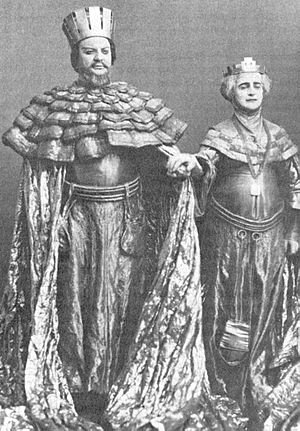Antagonist facts for kids
An antagonist is a character in a story who works against the main hero or character, known as the protagonist. They are often seen as the main enemy or rival. The antagonist creates problems and challenges that the main character must overcome.
Contents
Where the Word Comes From
The English word "antagonist" comes from the ancient Greek word antagonistēs. This word means "opponent," "competitor," "villain," "enemy," or "rival." It is made up of two parts: anti- which means "against," and agonizesthai which means "to compete for a prize."
Different Kinds of Antagonists
Heroes, Villains, and In-Between
Often, the antagonist is placed against the protagonist and their world. In many stories, the protagonist is the hero and the antagonist is the villain. A good example is Harry Potter (the hero) and Lord Voldemort (the villain) in the Harry Potter books.
However, the antagonist is not always the villain. Sometimes, the main character (protagonist) might be a villain, and the antagonist is a hero who opposes them. For instance, in Death Note, Light Yagami is the protagonist (a villain), and L is the antagonist (a hero trying to stop him).
Antagonists are usually shown making choices that are not as good as the protagonist's. This helps create conflict in the story. But this is not always the case. For example, in William Shakespeare's play Macbeth, Macduff is the antagonist. He is morally right to fight the cruel ruler Macbeth, who is the protagonist.
Some famous antagonists from television include J.R. Ewing from Dallas and Alexis Colby from Dynasty. These characters became very popular and helped make their shows more watched.
Not Always Evil Characters
Characters can be antagonists without being evil. They might just be annoying or make bad decisions that affect the protagonist. In some stories, like The Catcher in the Rye, almost every character except the protagonist might act as an antagonist.
Another example is Javert in Victor Hugo's Les Misérables. Javert does not have bad intentions. Instead, he represents the very strict and unbending application of the law, even when it causes moral problems for others.
When the Antagonist is Part of the Hero
Sometimes, an antagonist isn't a separate person. It can be a part of the protagonist's own personality or a trait they have. For example, a character's own indecisiveness or a moral struggle they face could act as an antagonist.
Antagonists That Aren't People
An antagonist is not always a person or a group of people. In some stories, the antagonist can be a force of nature, like a huge tidal wave that destroys a city, or a terrible storm that causes chaos. It could even be the harsh conditions of a certain place that cause problems. These non-personal antagonists may or may not create direct obstacles for the protagonist.
Rules of society or other strict guidelines can also act as antagonists in a story.
Why Antagonists are Used in Stories
An antagonist is used as a tool in storytelling to create conflicts, obstacles, or challenges for the main character. While not every story needs an antagonist, they are often used in plays to make the drama more intense. In sad stories (tragedies), antagonists often cause the main character's biggest problem. In funny stories (comedies), they usually get the protagonist into funny situations.
How Writers Create Antagonists
Author John Truby explains that a true opponent not only tries to stop the hero from getting what they want, but also wants the same goal as the hero. According to Truby, "It is only by competing for the same goal that the hero and the opponent are forced to come into direct conflict and to do so again and again throughout the story." This shared goal makes the story more exciting and keeps the hero and antagonist clashing.
See also
 In Spanish: Antagonista (narratología) para niños
In Spanish: Antagonista (narratología) para niños
- Archenemy
- Villain


